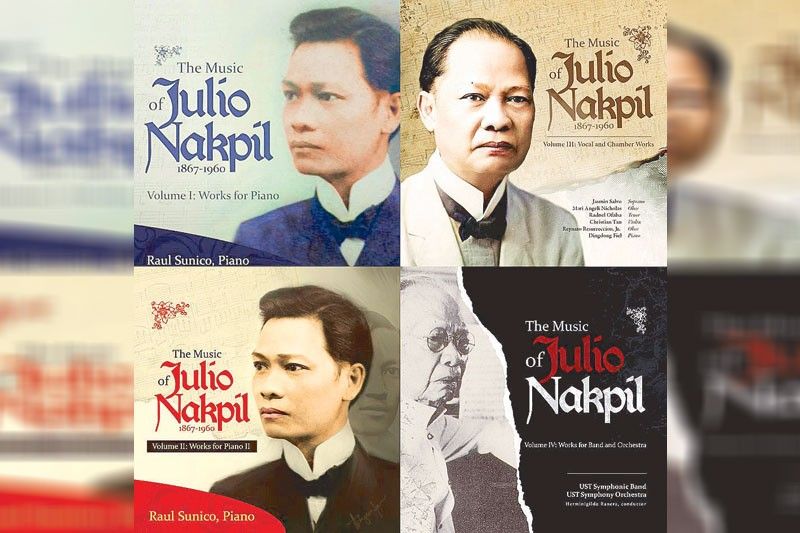The genius of Julio Nakpil

FamiluiarHistorians and I must say, also musicians of the future will now have no difficulty learning about the life and works of the esteemed Filipino musician and patriot Julio Nakpil (1867-1980). While information about his contemporaries is usually scant or sadly non-existent, Nakpil’s has now become readily available.
This is because almost everything about the Quiapo-born genius who fought alongside Andres Bonifacio has now been preserved online, in print, on record, etc., in ways he most surely never imagined during his lifetime. This is thanks to the massive research study labeled the Julio Nakpil Music Project.
Set to be launched officially on May 22, which is Nakpil’s 155th birth anniversary, the Julio Nakpil Music Project was funded by the Salikha Creative Grants from the Commission on Higher Education and the National Commission on Culture and the Arts (CHED-NCCA). The research study was implemented by the University of Santo Tomas Research Center for Culture, Arts and Humanities with historical musicologist Prof. Maria Alexandra Inigo-Chua, PhD at the helm.
It took several years given the COVID-19 pandemic and other delays but the Julio Nakpil Project is now complete. Of course, there is always the chance that there are other documents, music sheets and memorabilia the Project was not able to unearth and which hopefully might be revealed in the future. But for now, whatever exists has been preserved for the delectation of historians and music lovers.
The Julio Nakpil Project consists of the following: The Julio Nakpil Music Documentary where family and experts talk about his life and music; the music folio, The Julio Nakpil Music Edition Volume 1 featuring Works for Piano, Voice and Chamber Ensemble; Ang Bahay ni Giliw, a physical and online exhibit on the life and works of Julio Nakpil. Giliw was Nakpil’s nom de guerre as a member of the Katipunan; and the centerpiece of the project, the recording of all of Nakpil’s works.
Distributed on all platforms by Viva Music, The Music of Julio Nakpil consists of four albums and covers the years 1890 to 1944, which were Nakpil’s most productive as a musician. Volume One, Works for Piano features the world-famous Raul Sunico playing light pieces inspired by Nakpil’s experiences as a famous young pianist in cosmopolitan Manila of the late 1800s. Among these are the polka Cefiro (Zephyr), his first composition; La Brisa Nocturna (The Night Breeze), a habanera; and the famous Recuerdos de Capiz (Capiz Souvenirs), a habanera caracteristica.
Volume Two consists of more compositions for solo piano which are also performed by Sunico. Nakpil, the dance music provider of tertulias and balls in Manila was changing. He had discovered the simmering uprising against Spain. So, alongside the waltz Clotilde and the polka Teatro Luisa, there are Pahimakas, a funeral march in honor of the executed Jose Rizal, Pasig-Pantayanin, a paso doble dedicated to the patriots; and Balintawak which memorializes the first cry of the revolution.
An interesting cut is the waltz, Johny and Little Julia which Nakpil wrote for his two children. He got married to Andres Bonifacio’s widow Gregoria de Jesus in Quiapo Church on Dec. 10, 1898 and their first son was Juan and first daughter was Julia. Juan grew up to become a National Artist for Architecture.
Volume Three contains Nakpil’s Works for Voice and Chamber Ensemble. Although he had no formal music training and only spent two years in school as a boy, Nakpil ventured into arranging for piano, voice and other instruments. One of these is Pag-ibig from 1897 which was dedicated to Oryang which is performed as a duet by soprano Jasmin Salvo and tenor Radnel Ofalsa with Dingdong Fiel on piano.
Also included here is Marangal Na Dalit ng Katagalugan (Himno Nacional), performed by the Coro Tomasino. It was Bonifacio who requested Nakpil to write this piece which could have been the Philippine National Anthem if Emilio Aguinaldo did not become president.
As he got older and life became more complex, Nakpil continued to use music to express his feelings. These are very evident in Volume Four, which is made up of Works for Band and Orchestra and which are performed by the UST Symphony Band and the UST Symphony Orchestra conducted by Herminigildo Ranera.
Among these are Sueno Eterno, a marcha funebre dedicated to Nakpil’s father; Kabanatuan, another funeral march dedicated to the slain general Antonio Luna; Deus Omnipotens on the death of Oryang in 1943 and in memory of his fallen comrades in the revolution; and Salve Patria (Hail Motherland), a march for the inauguration of Rizal’s monument in Luneta.
Julio Nakpil was a Filipino of immense talent who produced great music while weaving in and out of historic events during his lifetime. Every Filipino should be made aware of his accomplishments. I am thankful that this has now become possible.
- Latest
- Trending



























